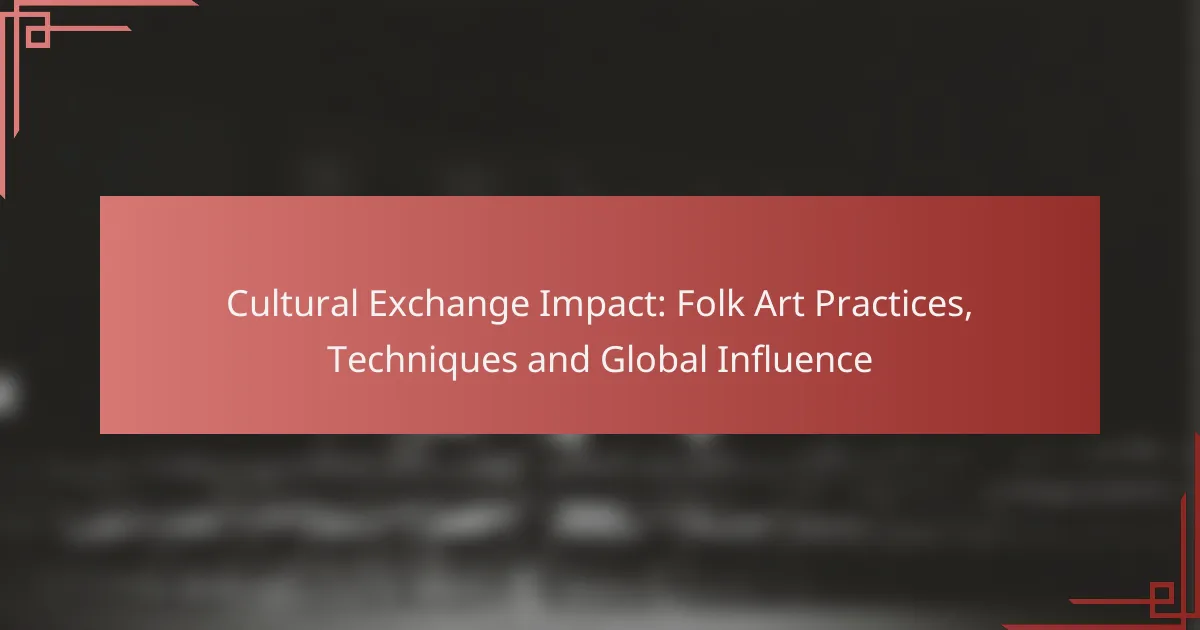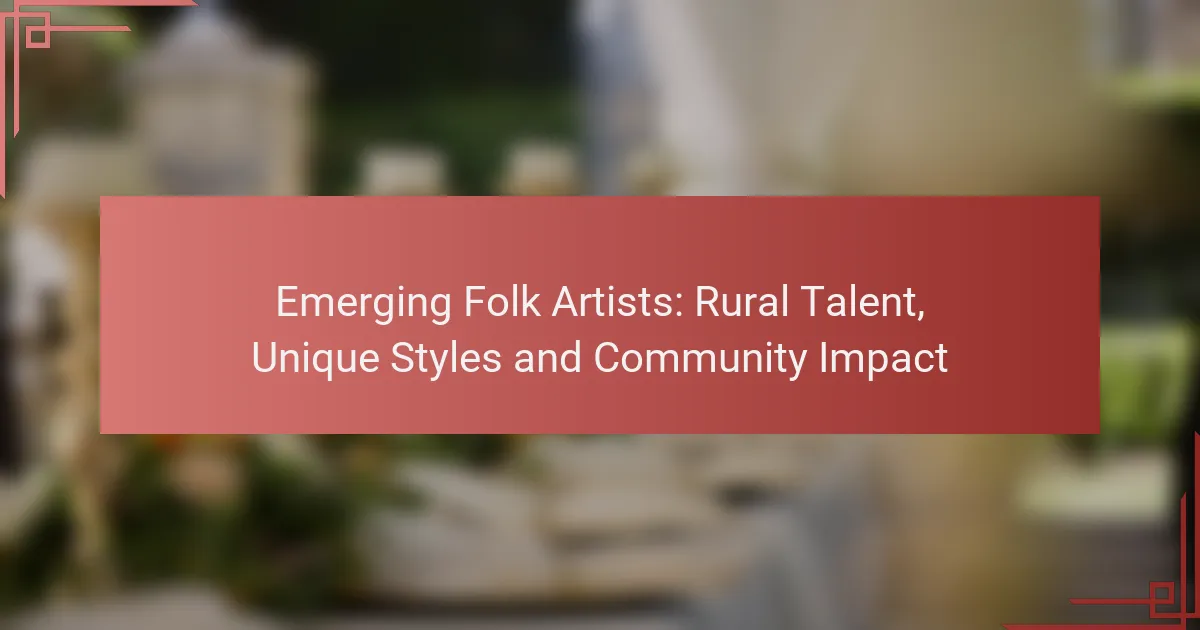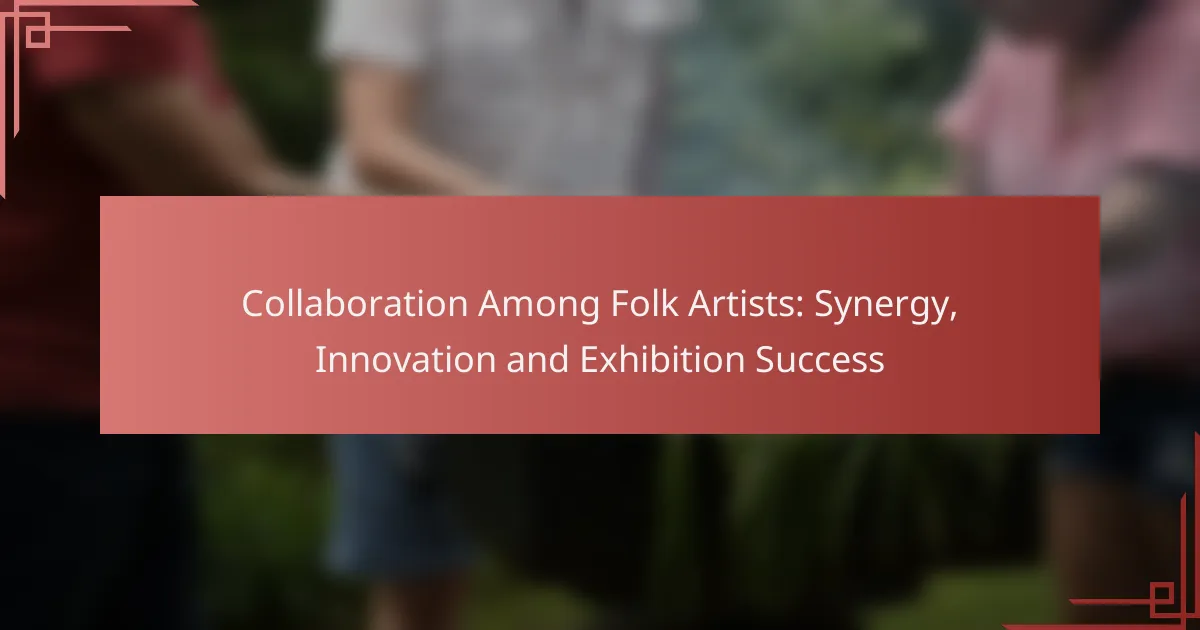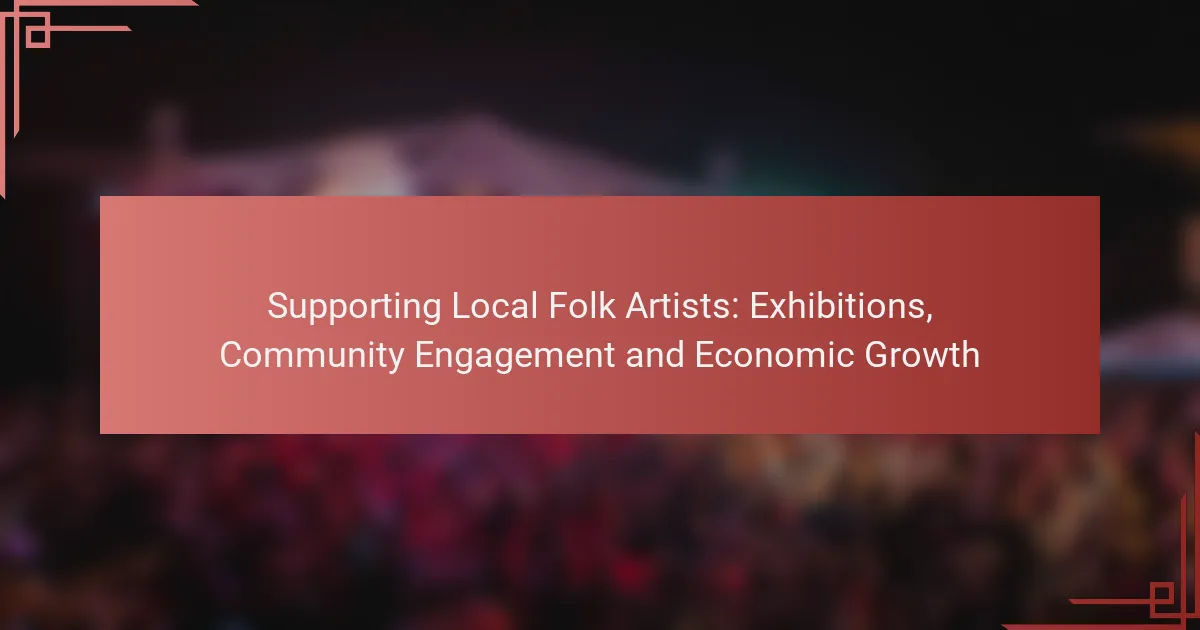Cultural exchange through folk art plays a vital role in sharing traditions, stories, and techniques among diverse communities, particularly in Europe. By showcasing unique practices and materials, folk art reflects local heritage and fosters mutual understanding, enriching the global cultural landscape.
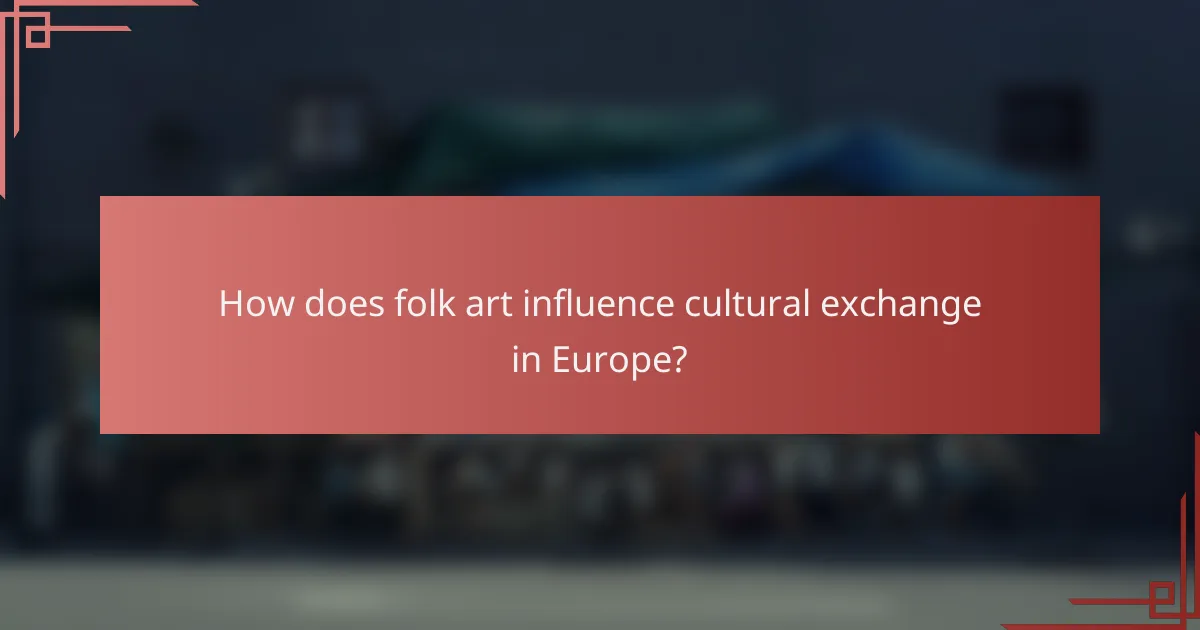
How does folk art influence cultural exchange in Europe?
Folk art significantly influences cultural exchange in Europe by serving as a medium for sharing traditions, stories, and techniques among diverse communities. This exchange fosters mutual understanding and appreciation, enriching the cultural landscape across the continent.
Historical significance in community identity
Folk art plays a crucial role in shaping community identity by reflecting local traditions, values, and histories. Each region in Europe has its unique folk art forms, such as Polish wycinanki (paper cuttings) or Spanish flamenco textiles, which embody the cultural narratives of their people.
These art forms often serve as symbols of pride and continuity, helping communities maintain a sense of belonging and heritage. Festivals and exhibitions showcasing folk art can strengthen community bonds and promote cultural tourism.
Preservation of traditional techniques
The preservation of traditional techniques is vital for sustaining folk art practices across Europe. Many artisans dedicate themselves to mastering age-old methods, such as weaving, pottery, or wood carving, which have been passed down through generations.
Efforts to document and teach these techniques are essential for ensuring their survival. Workshops, apprenticeships, and cultural programs often facilitate this knowledge transfer, allowing younger generations to engage with their cultural heritage while adapting it to contemporary contexts.
Impact on contemporary art movements
Folk art has a noticeable impact on contemporary art movements in Europe, inspiring artists to incorporate traditional elements into modern works. This fusion can be seen in various mediums, including painting, sculpture, and installation art, where artists reinterpret folk motifs and techniques.
Exhibitions that highlight this blend often challenge conventional boundaries, encouraging dialogue between traditional and contemporary art forms. The result is a vibrant artistic landscape that honors the past while embracing innovation, appealing to both local and international audiences.
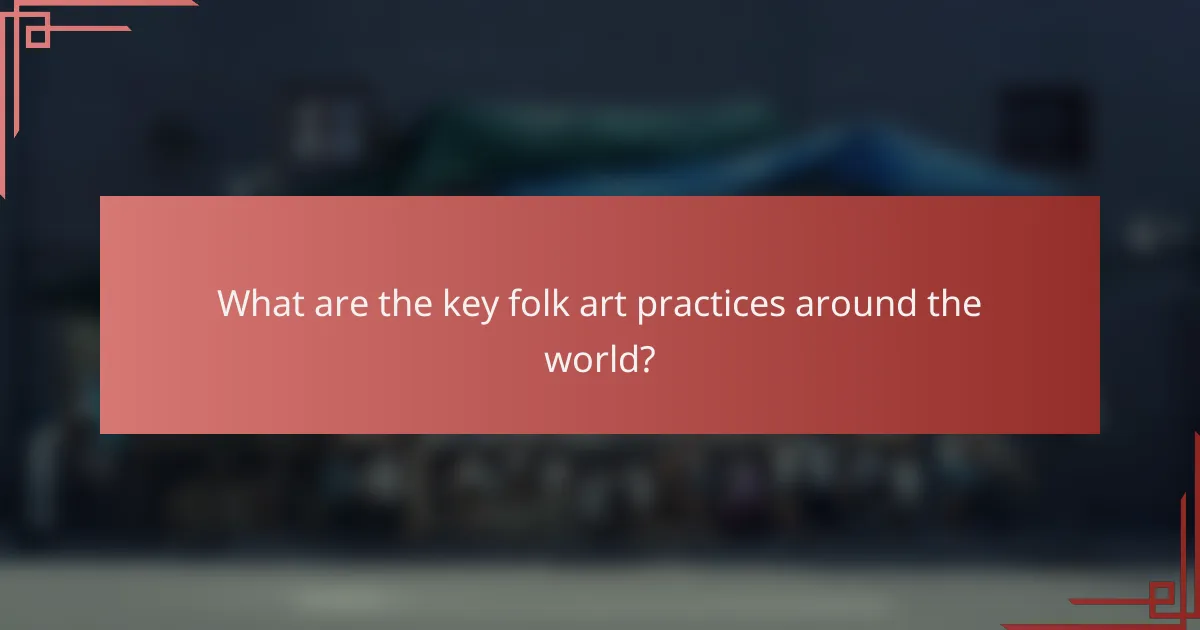
What are the key folk art practices around the world?
Key folk art practices vary widely across cultures, reflecting local traditions, beliefs, and techniques. These practices often involve unique materials and methods, showcasing the creativity and heritage of communities globally.
Mexican Day of the Dead altars
Mexican Day of the Dead altars, or “ofrendas,” are vibrant displays honoring deceased loved ones. These altars typically include photographs, candles, flowers, and favorite foods of the departed, creating a space for remembrance and celebration.
When constructing an ofrenda, consider using marigolds, which symbolize the fragility of life, and papel picado, colorful paper cutouts that represent the wind. Each element serves a purpose, inviting spirits back to the world of the living.
Indian Warli painting techniques
Warli painting, originating from the Warli tribe in Maharashtra, India, employs simple geometric shapes to depict daily life and nature. This folk art uses a white pigment made from rice paste on a mud base, creating striking contrasts.
To create Warli art, start with a mud wall or canvas and use a twig or brush to apply the rice paste. Common themes include farming, hunting, and festivals, reflecting the community’s connection to nature and spirituality.
Japanese origami traditions
Japanese origami, the art of paper folding, transforms simple sheets of paper into intricate designs, ranging from animals to geometric shapes. This practice emphasizes precision and creativity, often using a square piece of paper without cuts or glue.
To begin with origami, select a quality paper that holds creases well. Start with basic folds like the valley and mountain folds, then progress to more complex models. Resources like books or online tutorials can guide beginners through various designs.
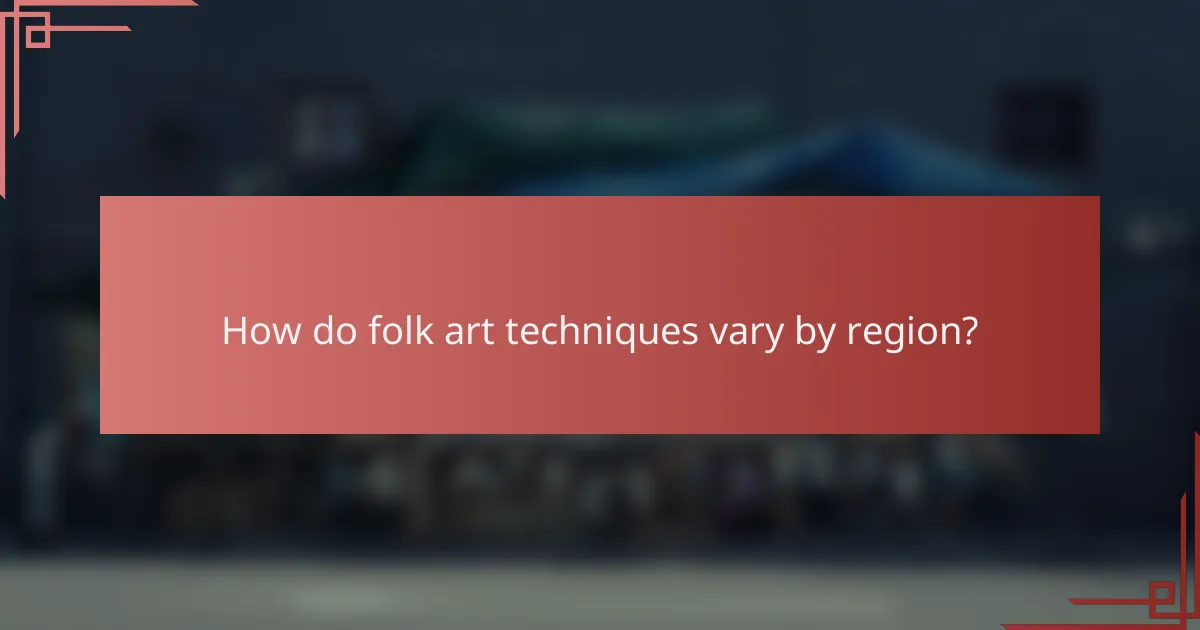
How do folk art techniques vary by region?
Folk art techniques differ significantly across regions, influenced by local materials, cultural traditions, and historical contexts. Each area showcases unique practices that reflect its heritage and community values.
Textile weaving in South America
Textile weaving in South America is characterized by vibrant colors and intricate patterns, often using natural fibers like cotton and wool. Techniques vary widely, with indigenous communities employing methods such as backstrap weaving and loom weaving, each producing distinct styles.
For example, the Andean region is known for its use of geometric designs, while the Amazonian tribes often incorporate motifs that reflect their natural surroundings. When engaging in textile weaving, consider sourcing local materials to maintain authenticity and support regional artisans.
Pottery styles in Africa
African pottery styles are diverse, with techniques varying from hand-building to wheel-throwing, depending on the region. Many communities utilize clay sourced from local environments, which influences the texture and color of the final products.
In West Africa, for instance, pottery often features elaborate surface decorations and is used for both functional and ceremonial purposes. When creating pottery, it’s essential to understand the cultural significance of the designs and to respect traditional practices to honor the craft’s heritage.
Wood carving in Scandinavia
Wood carving in Scandinavia is renowned for its craftsmanship and functional artistry, often reflecting the region’s natural landscapes. Techniques include relief carving and in-the-round carving, with motifs that frequently draw inspiration from folklore and nature.
Scandinavian woodcarvers typically use local woods such as birch and pine, which are well-suited for intricate designs. If you are interested in wood carving, consider starting with simple projects that allow you to practice basic techniques before progressing to more complex designs that embody cultural stories.

What role do festivals play in cultural exchange?
Festivals serve as vibrant platforms for cultural exchange, allowing diverse communities to share and celebrate their traditions. Through folk art, music, and dance, festivals foster understanding and appreciation among different cultures, enhancing social cohesion and global interconnectedness.
Showcasing folk art at international festivals
International festivals provide a unique opportunity for folk artists to present their work to a global audience. These events often feature traditional crafts, performances, and culinary arts, allowing attendees to experience various cultural expressions firsthand. For example, festivals like the Edinburgh Festival Fringe or the Smithsonian Folklife Festival highlight the richness of folk art from around the world.
Participating in these festivals can significantly boost an artist’s visibility and marketability. Artists can network with peers and potential buyers, leading to collaborations and sales that may not be possible in their local contexts.
Community engagement through art
Festivals encourage community engagement by involving local residents in the planning and execution of events. This participation fosters a sense of ownership and pride in cultural heritage, as community members contribute their skills and knowledge to showcase their traditions. Workshops and interactive exhibits allow festival-goers to engage directly with folk art practices, deepening their understanding and appreciation.
Moreover, festivals can serve as a catalyst for social change by addressing contemporary issues through art. For instance, some festivals incorporate themes of sustainability or social justice, prompting discussions that resonate with both local and international audiences.
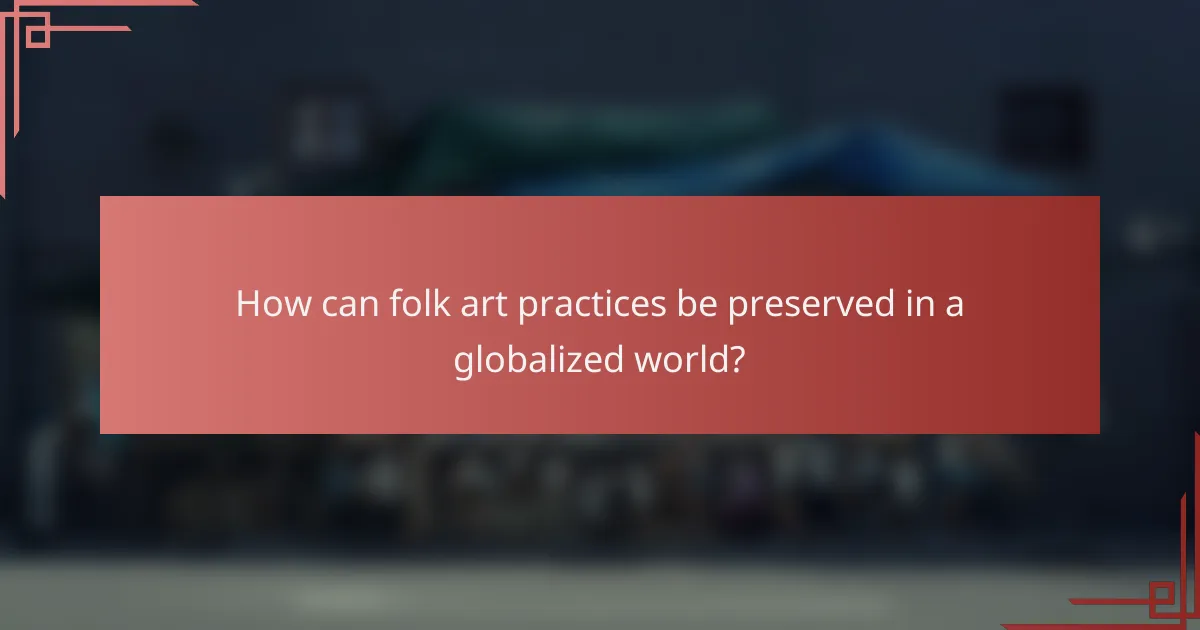
How can folk art practices be preserved in a globalized world?
Folk art practices can be preserved in a globalized world through community support, education, and active engagement with local artisans. By fostering appreciation for traditional techniques and encouraging their integration into contemporary culture, we can ensure these practices thrive despite global influences.
Support for local artisans
Supporting local artisans is crucial for the preservation of folk art. This can be achieved through purchasing their work, promoting their crafts in local markets, and providing platforms for visibility, such as online stores or exhibitions. Engaging with local artisans helps maintain traditional techniques and encourages the next generation to learn these skills.
Additionally, community initiatives can create a network of support, where artisans collaborate and share resources. This not only strengthens their economic position but also fosters a sense of cultural pride and continuity.
Education and workshops
Education plays a vital role in preserving folk art practices. Workshops can be organized to teach traditional techniques to both locals and visitors, ensuring that knowledge is passed down. These sessions can range from short classes to longer courses, allowing participants to immerse themselves in the craft.
Schools and community centers can incorporate folk art into their curricula, emphasizing its cultural significance. By making folk art accessible and relevant, we encourage appreciation and participation, which are essential for its survival in a rapidly changing world.
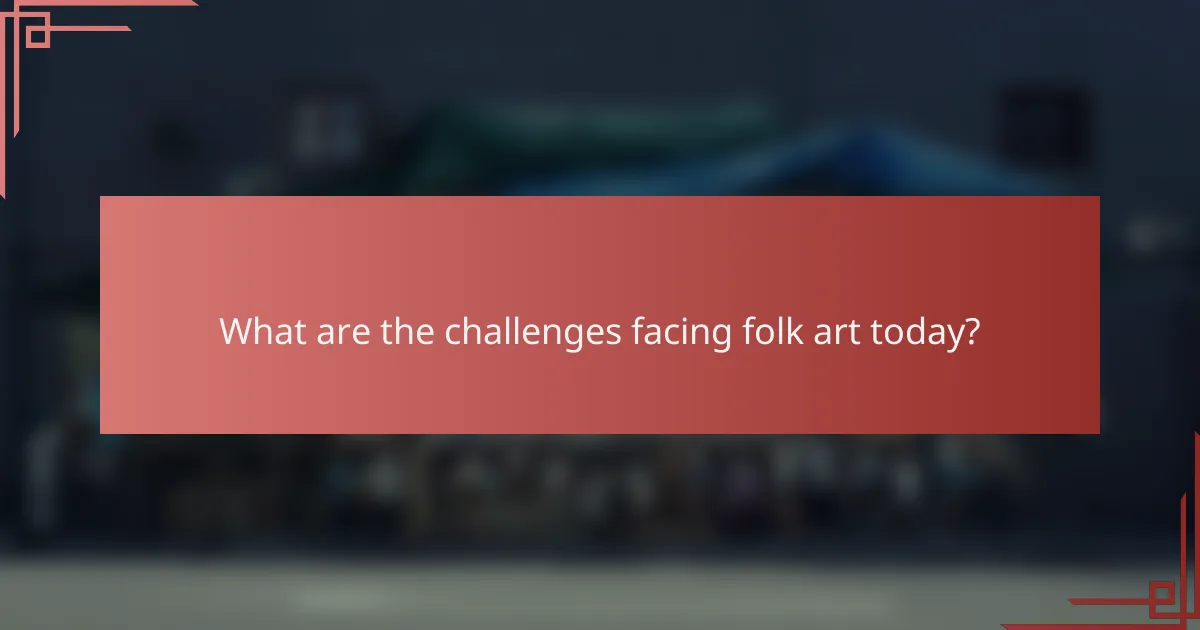
What are the challenges facing folk art today?
Folk art faces several significant challenges, including commercialization and the loss of cultural heritage. These issues threaten the authenticity and sustainability of traditional practices, impacting both artists and communities.
Commercialization of traditional practices
The commercialization of folk art often leads to the dilution of traditional techniques and styles. As artists adapt their work to meet market demands, the original cultural significance may be overshadowed by profit motives.
For example, in many regions, artisans may produce mass-market items that mimic traditional designs but lack the depth of meaning and craftsmanship. This shift can result in a loss of unique artistic identity and a focus on quantity over quality.
Loss of cultural heritage
The loss of cultural heritage is a pressing concern for folk art, as globalization and urbanization contribute to diminishing local practices. Younger generations may gravitate towards modern art forms, leaving traditional skills at risk of extinction.
Efforts to preserve folk art must include education and community engagement. Initiatives that promote workshops, festivals, and cultural exchanges can help revitalize interest in traditional crafts and ensure their transmission to future generations.
